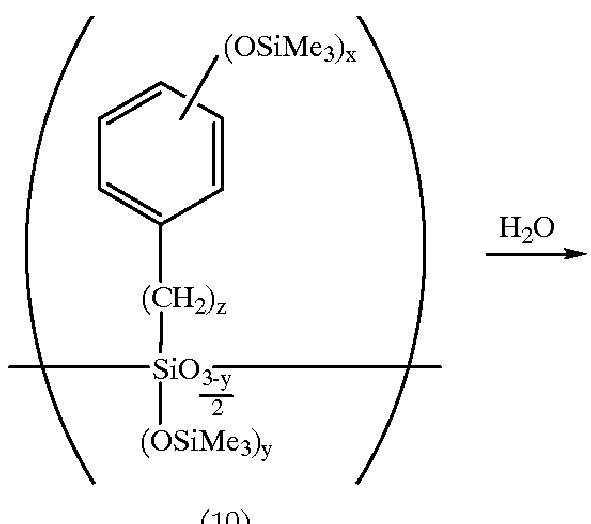High molecular weight silicone compounds, chemically amplified positive resist compositions, and patterning method
a technology of chemical amplification and composition, applied in the direction of photosensitive materials, instruments, photomechanical equipment, etc., can solve the problems of difficult application of silanols to chemical amplified positive resist materials, and difficult to achieve high aspect ratio fine pattern formation
- Summary
- Abstract
- Description
- Claims
- Application Information
AI Technical Summary
Benefits of technology
Problems solved by technology
Method used
Image
Examples
synthesis example 1
Synthesis of poly(p-hydroxybenzylsilsesquioxane)
A reactor was charged with 1,200 ml of water. With stirring at 30.degree. C., a mixture of 487.2 g (2.0 mol) of p-methoxybenzyltrichlorosilane and 600 ml of toluene was added dropwise over 2 hours for hydrolysis. The aqueous layer was separated off and the organic layer was repeatedly washed with water until the water layer became neutral. Hexamethylsilazane, 80 g, was added to the organic layer, which was refluxed for 5 hours. After cooling, the toluene and unreacted hexamethylsilazane were evaporated off by means of an evaporator. The residue was dissolved in 400 g of acetonitrile. Trimethylsilyl iodide, 480 g, was added dropwise to the solution below 60.degree. C. Reaction was continued for 10 hours at 60.degree. C. After the completion of reaction, 200 g of water was added to the reaction solution for hydrolysis. The polymer layer was collected by decantation. After the solvent was evaporated off by means of an evaporator, the poly...
synthesis example 2
In a 2-liter flask, 160 g of the poly(p-hydroxybenzylsilsesquioxane) obtained in Synthesis Example 1 was dissolved in 1,000 ml of dimethylformamide, and a catalytic amount of p-toluenesulfonic acid was added. With stirring at 20.degree. C., 19.0 g of ethyl vinyl ether and 6.0 g of triethylene glycol divinyl ether were added. After one hour of reaction, the reaction solution was neutralized with conc. aqueous ammonia, and the neutralized solution was added dropwise to 10 liters of water whereupon a white solid formed. After filtration, the solid was dissolved in 500 ml of acetone, which was added dropwise to 10 liters of water. After filtration, the polymer was dried in vacuum. It was ascertained from .sup.1 H-NMR analysis of the polymer, designated Polym.1, that 20% of the hydrogen atoms of hydroxyl groups in poly(p-hydroxybenzylsilsesquioxane) were ethoxyethylated and 3% crosslinked.
synthesis example 3
A polymer was prepared as in Synthesis Example 2 except that 5.0 g of 1,4-di(vinylether)cyclohexanone was used instead of the triethylene glycol divinyl ether. It was ascertained from .sup.1 H-NMR analysis of the polymer, designated Polym.2, that 20% of the hydrogen atoms of hydroxyl groups in poly(p-hydroxybenzylsilsesquioxane) were ethoxyethylated and 2.5% crosslinked.
PUM
| Property | Measurement | Unit |
|---|---|---|
| wavelength | aaaaa | aaaaa |
| wavelength | aaaaa | aaaaa |
| wavelength | aaaaa | aaaaa |
Abstract
Description
Claims
Application Information
 Login to View More
Login to View More - R&D
- Intellectual Property
- Life Sciences
- Materials
- Tech Scout
- Unparalleled Data Quality
- Higher Quality Content
- 60% Fewer Hallucinations
Browse by: Latest US Patents, China's latest patents, Technical Efficacy Thesaurus, Application Domain, Technology Topic, Popular Technical Reports.
© 2025 PatSnap. All rights reserved.Legal|Privacy policy|Modern Slavery Act Transparency Statement|Sitemap|About US| Contact US: help@patsnap.com


